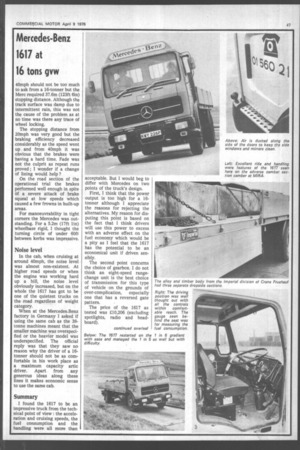Mercedes-Benz 1617 at 16 tons gvw
Page 49

If you've noticed an error in this article please click here to report it so we can fix it.
40mph should not be too much to ask from a 16-tonner but the Merc required 37.6m (123ft 6in) stopping distance. Although the track surface was damp due to intermittent rain, this was not the cause of the problem as at no time was there any trace of wheel locking.
The stopping distance from 20mph was very good but the braking efficiency decreased considerably as the speed went up and from 40mph it was obvious that the brakes were having a hard time. Fade was not the culprit as repeat runs proved ; I wonder if a change of lining would help ?
On the road section of the operational trial the brakes performed well enough in spite of a severe attack of brake squeal at low speeds which caused a few frowns in built-up areas.
For manoeuvrability in tight corners the Mercedes was outstanding. For a 5.2m (17ft lin) wheelbase rigid, I thought the turning circle of under 60ft between kerbs was impressive.
Noise level
In the cab, when cruising at around 40mph, the noise level was almost non-existent. At higher road speeds or when the engine was working hard up a hill, the noise level obviously increased, but on the whole the 1617 has got to be one of the quietest trucks on the road regardless of weight category.
When at the Mercedes-Benz factory in Germany I asked if using the same cab as the 38tonne machines meant that the smaller machine was overspecified or the heavier model was underspecified. The official reply was that they saw no reason why the driver of a 16tonner should not be as comfortable in his work place as a maximum capacity artic driver. Apart from any generous ideas along these lines it makes economic sense to use the same cab.
Summary
I found the 1617 to be an impressive truck from the technical point of view : the acceleration and cruising speeds, the fuel consumption and the handling were all more than acceptable. But I would beg to differ with Mercedes on two points of the truck's design.
First, I think that the power output is too high for a 16tonner although I appreciate the reasons for rejecting the alternatives. My reason for disputing this point is based on the fact that I think drivers will use this power to excess with an adverse effect on the fuel economy which would be a pity as I feel that the 1617 has the potential to be an economical unit if driven sensibly.
The second point concerns the choice of gearbox. I do not think an eight-speed rangechange unit is the best choice of transmission for this type of vehicle on the grounds of over-complication, especially one that has a reversed gate pattern.
The price of the 1617 as tested was £10,206 (excluding spotlights, radio and headboard).
continued overleaf




























































































































